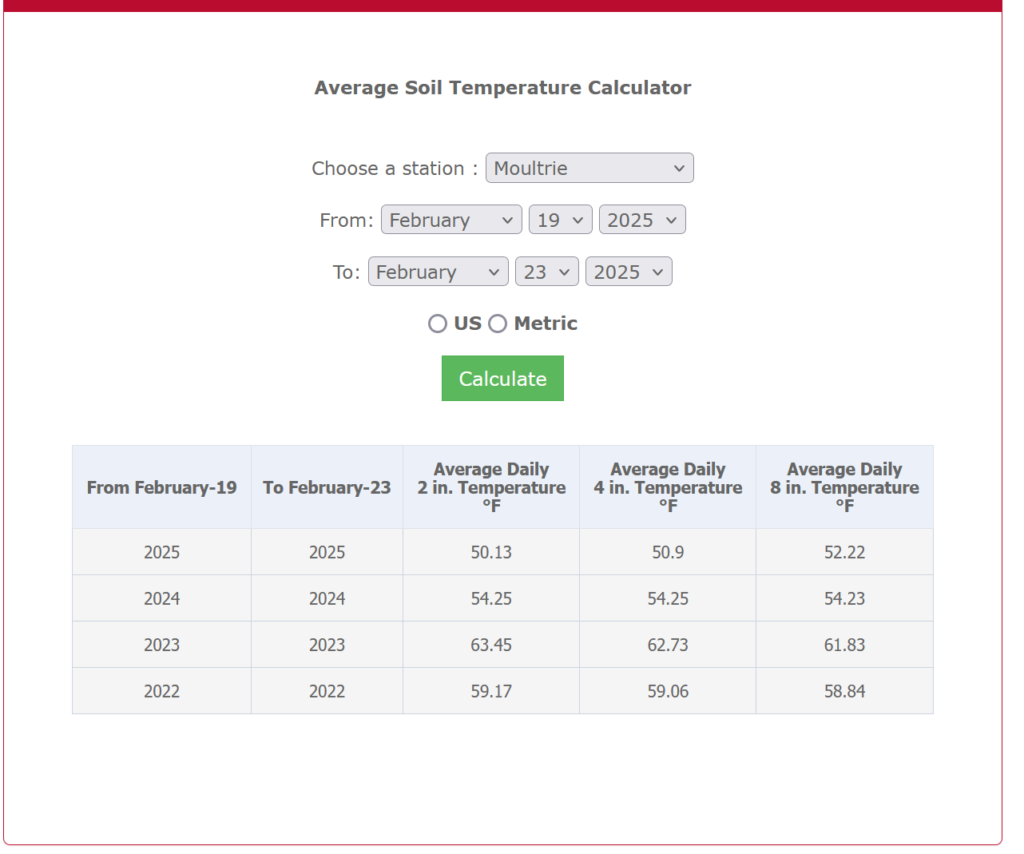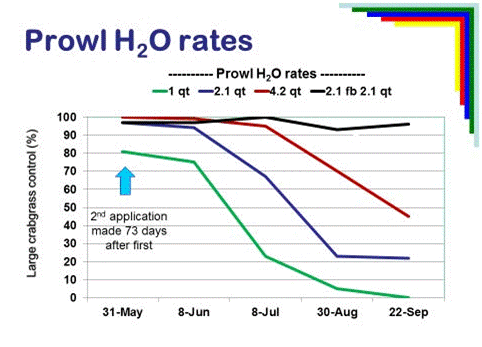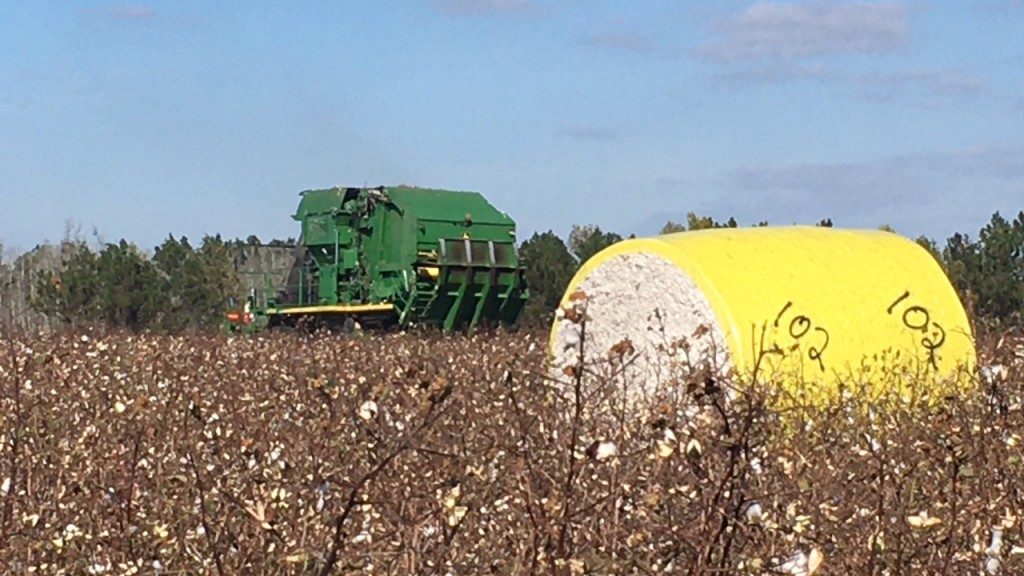In this issue: What are the current soil temps? Colquitt County Forage Production Update, Corn Burndown, Cotton Acreage Survey, Prowl on forages, Influence of storage length on the nutritive value of baleage, EVALUATING FUNGICIDES FOR MANAGEMENT OF AREOLATE MILDEW IN GEORGIA.
What are the current soil temps? Soil temperatures for three depths are listed below for the period of Feb 19-23, 2025. This data is from the Sunbelt Expo location of the UGA Weather Network. For corn planting At planting soil temperatures at the 2-inch depth should be at or exceed 55 degrees F.


I have been getting a question or two about cover crop termination timing and corn planting. Dr. Eric Prostko, UGA Corn Weed Specialist, suggests that generally, the optimum timing for cover crop control in field corn is 10-14 days before planting. Planting into green cover can result in corn yield losses (up to 10% in some trials).
1) What is the plant-back restriction for field corn following an application of 2,4-D?
Plant-back restrictions for field corn after a burndown application of 2,4-D are 7 days (16 oz/A) or 10-14 days (>16 oz/A)
2) If a grower cannot wait to plant field corn in 7-14 days after an application of 2,4-D, what other burndown options are available?
Roundup (glyphosate) or Gramoxone** (paraquat) + Atrazine 4L (32 oz/A) is my first choice. There are no field corn plant-back restriction for these treatments.
This past week there were several articles about the National Cotton Council Acreage Survey. The article below is by Dr. Scott Graham, that appeared in the latest Alabama Cotton Shorts Newsletter.
National Cotton Council Acreage Survey. The following is an exert from Cotton Grower Magazine. U.S. cotton producers intend to plant 9.6 million cotton acres this spring, down 14.5% from 2024, according to the National Cotton Council’s 44th Annual Early Season Planting Intentions Survey. Upland cotton intentions are 9.4 million acres, down 14.4% from 2024, while extra-long staple (ELS) intentions of 158,000 acres represent a 23.5% decline. The detailed survey results were announced Feb. 16 during the 2025 National Cotton Council Annual Meeting. To continue reading, click here.
What rate of prowl do I use on my hay field? Dr. David Russel, Alabama Cooperative Extension Forage Weed Specialist drafted an article about different rates and application timings of Prowl H2O. The graph below shows that the length of residual crabgrass control increases with the Prowl H2O rate. The 4.2 quart per A rate provided about 12 weeks control but not full-season. However, the split-application of 2.1 quart followed by 2.1 quart did provide season-long control and was the only treatment to do so.

Researchers at Penn State and the University of Delaware compared single (early spring) applications of Prowl H2O to a split application applied prior to crabgrass emergence. Graph and data used with permission by Mark VanGessel, University of Delaware.
https://www.aces.edu/blog/topics/farming/prowl-h2o-on-forages/ Published on January 18, 2024
Influence of storage length on the nutritive value of baleage
I had a couple of questions this past week about how long can I keep my baleage? A study was conducted at the University of Georgia by Burt, et al., 2024, to determine the effect of storage length on nutritive value of forage harvested and stored as baleage and the results were published this past year in the Journal of Crop, Forage and Turfgrass Management. This study evaluated baleage harvested from 2016 to 2018 in Tifton, GA, consisting of either bermudagrass (Cynodon dactylon L. Pers.), or a mixture of bermudagrass and alfalfa (Medicago sativa L.). Baleage was sampled for nutritive value analysis at 6-weeks and 9- and 12-months post-harvest, with a subset of bales sampled at 24 months.
The table below shows the nutritive value of alfalfa–bermudagrass and bermudagrass baleage stored up to 12-months post-harvest in Tifton, GA from 2016 to 2018. This data is pooled across year and harvest.

The results from this study showed that baleage may be safely stored for up to 12-month post-harvest before feeing out and still meet the needs of beef cattle with high nutrient demands. However, extended storage up to 24-month is not recommended as all evaluated nutritive value parameters were negatively impacted by the additional year in storage. Forages stored for 24 months had greater fiber fractions and did not maintain TDN values necessary to support growing stocker animals or those in lactation. While longer storage should not have a major impact on nutritive value, maintaining bale integrity for longer than 9 months is still a challenge and may jeopardize the integrity of the plastic. Regardless, it is still recommended that producers should test stored forages to confirm the nutritive value of their baleage when developing a feeding strategy for their livestock. Additional research is needed to determine changes in fermentation profiles, specifically lactic acid concentration, over time with prolonged storage periods.
If you would like to read about this research it is available here.
EVALUATING FUNGICIDES FOR MANAGEMENT OF AREOLATE MILDEW IN GEORGIA
This past year I had the opportunity to do an on-farm trial evaluating the control of Areolate mildew with various fungicides. The results of this project were presented at the 2025 Beltwide Cotton Conference held in New Orleans. Four fungicide treatments were applied with a grower sprayer, and each treatment was replicated three times across a field that had a history of Areolate mildew during the third week of bloom. DPL 2333 was planted at the Colquitt County location. This was also conducted at Stripling Irrigation Research Park (SIRP) in Mitchell County. The plots at SIRP were four rows by forty feet long, and each treatment was replicated 4 times during the 4th week of bloom with a spider sprayer. DPL 2038 was planted at the SIPR location. The treatments for both locations are listed below.

Results from SIRP: The plots were rated at 33 DAT (days after treatment) the Miravis Top (6 %) and Abound + Suffa (7 %) significantly reduced canopy defoliation compared to the untreated check (36%). At 47 DAT, the Miravis Top (6 %) significantly reduced canopy defoliation compared to Abound (28%) and the untreated check (55%). The Abound (28%) was no different compared to the Abound + Suffa (24%) at this time.

Results of this study showed no significant differences in yield at harvest among all treatments. Lint yields ranged from 1048 to 1094 lb/A.

At 33 DAT no significant differences were noted in defoliation among treatments. Canopy defoliation ranged from 0.6 to 12%. At 46 DAT, the Miravis Top (4 %) significantly reduced canopy defoliation compared to Abound (40%) but was not different when compared to the untreated check (16.6%). The Abound (40%) was numerically, but not statistically different as compared to the Abound + Suffa (16.6%) at this time.

No significant differences in yield at harvest among treatments but numerical differences were noted. The Abound + Suffa and Miravis Top treatments increased lint yields 80 to 100 lb/A compared to the untreated check.

Why did the Abound + Suffa do so well in Colquitt County and not at SIPR? That is a great question. Dr. Bob Kemerait mentioned that diseased leaf samples were collected at each site and submitted to the UGA Molecular Plant Disease Diagnostic Lab at the UGA Tifton Campus. Samples of R. pseudoglycines from the SIPR location in Mitchell County did not have the gene mutation for resistance to QoI fungicides. At that location, azoxystrobin still effectively reduced premature defoliation as compared to the untreated control; Mixture of azoxystrobin + sulfur was not better than the azoxystrobin alone. Isolates of the R. pseudoglycines from the on-farm site in Colquitt County did have the gene mutation for QoI resistance. This explains why the numeric defoliation of azoxystrobin alone was greater than when sulfur was mixed with the azoxystrobin.
February Cattle on Feed and Feedlot Sizes
By: Josh Maples, Mississippi State University Extension
The February Cattle on Feed report was released this past Friday afternoon and reported 11.7 million head of cattle in feedlots on February 1st. This was a 0.7 percent decrease from February 1, 2024. Marketings were up 1.4 percent year-over-year. There were no big surprises in the report relative to pre-report expectations, but there were some interesting points in the report. READ MORE
If you have any questions please contact your local county Extension agent.
Have a great week,
Jeremy M. Kichler
Colquitt County Extension Coordinator
The University of Georgia Cooperative Extension does not endorse or guarantee the performance any products mentioned in this update.
